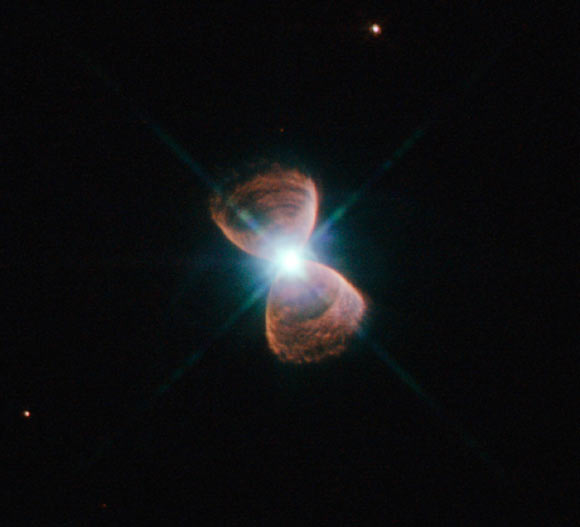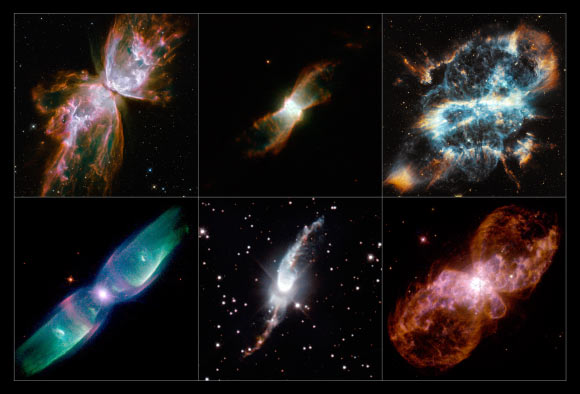Using NASA’s Hubble Space Telescope and ESO’s New Technology Telescope, two astronomers from University of Manchester, UK, have studied 130 planetary nebulae in our Milky Way galaxy. They have found that so-called butterfly-shaped nebulae tend to be mysteriously aligned.

This image shows the bipolar planetary nebula PN Hb 12, popularly known as Hubble 12, in the constellation of Cassiopeia. Image credit: NASA / ESA. Acknowledgement: Josh Barrington.
The final stages of life for a star like our Sun result in the star puffing its outer layers out into the surrounding space, forming objects known as planetary nebulae in a wide range of beautiful and striking shapes.
One type of such nebulae, known as bipolar planetary nebulae, create ghostly hourglass or butterfly shapes around their parent stars.
All these nebulae formed in different places and have different characteristics. Neither the individual nebulae, nor the stars that formed them, interact with other planetary nebulae.
However, a new study shows surprising similarities between some of these nebulae: many of them line up in the sky in the same way.
“This really is a surprising find and, if it holds true, a very important one. Many of these ghostly butterflies appear to have their long axes aligned along the plane of our galaxy. By using images from both Hubble and the NTT we could get a really good view of these objects, so we could study them in great detail,” said Dr Bryan Rees, who is a first author of a paper published in the Monthly Notices of the Royal Astronomical Society (arXiv.org).

This mosaic shows stunning images of bipolar planetary nebulae, from left to right: row 1 – NGC 6302, NGC 6881, NGC 5189; row 2 – M2-9, Hen 3-1475, Hubble 5 (ESA / NASA / Hubble Heritage Team / Hubble SM4 ERO Team).
The astronomers looked at 130 planetary nebulae in the Milky Way’s central bulge. They identified three different types, and peered closely at their characteristics and appearance.
“While two of these populations were completely randomly aligned in the sky, as expected, we found that the third – the bipolar nebulae – showed a surprising preference for a particular alignment. While any alignment at all is a surprise, to have it in the crowded central region of the galaxy is even more unexpected,” said study second author Dr Albert Zijlstra.
“The alignment we’re seeing for these bipolar nebulae indicates something bizarre about star systems within the central bulge. For them to line up in the way we see, the star systems that formed these nebulae would have to be rotating perpendicular to the interstellar clouds from which they formed, which is very strange,” Dr Rees added.
While the properties of their progenitor stars do shape these nebulae, this new finding hints at another more mysterious factor. Along with these complex stellar characteristics are those of our Milky Way; the whole central bulge rotates around the galactic center.
This bulge may have a greater influence than previously thought over our entire galaxy – via its magnetic fields. The astronomers suggest that the orderly behavior of the planetary nebulae could have been caused by the presence of strong magnetic fields as the bulge formed.
As such nebulae closer to home do not line up in the same orderly way, these fields would have to have been many times stronger than they are in our present-day neighborhood.
“We can learn a lot from studying these objects. If they really behave in this unexpected way, it has consequences for not just the past of individual stars, but for the past of our whole galaxy,” Dr Zijlstra said.
______
Bibliographic information: B. Rees, A. A. Zijlstra. Alignment of the Angular Momentum Vectors of Planetary Nebulae in the Galactic Bulge. MNRAS, published online September 4, 2013; doi: 10.1093/mnras/stt1300








